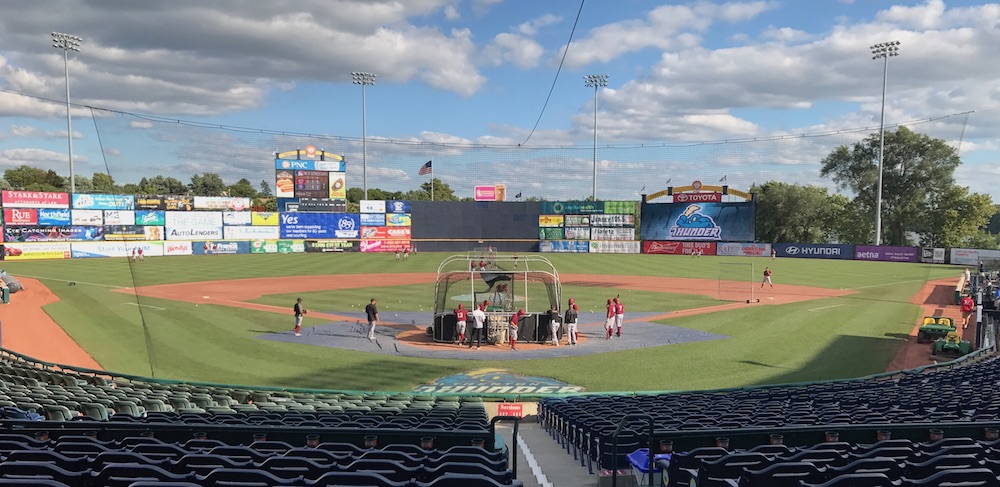Feature Photo: ARM & HAMMER Park, Trenton, N.J., home of the
Yankees’ Double-A Trenton Thunder Eastern League affiliate.
(Photo by Mark Shreve)
Here’s my thoughts on several prospects I’ve been viewing from ARM & HAMMER Park, home of the Double-A Eastern League’s Trenton Thunder (NYY), over the past few weeks, including the solid defense and hit tool of Pablo Reyes (2B/SS/CF, Pirates), and three arms coming out of the bullpen for the Thunder: LHP James Reeves, RHP Cale Coshow, and RHP Anyelo Gomez. I also profile Yankees outfielder Zack Zehner, who is holding down regular playing time in a farm system stacked with several legit outfield prospects thanks to his improving hit tool and defense, and who is quietly building a case as yet another player with future major league utility for the Bombers.
2080 Prospect Spotlights
 Pablo Reyes, 2B/SS/CF, Pirates (Double-A Altoona, Eastern League)
Pablo Reyes, 2B/SS/CF, Pirates (Double-A Altoona, Eastern League)
Ht/Wt: 5’10” / 150 lbs. B/T: R/L Age: (As of April 1, 2017): 23y, 6m
Reyes was an international signing in 2012 for the Pirates out of the Dominican Republic, and in his first taste of Double-A action this season, he has proven to be a versatile, athletic defender for Altoona, showing signs of a future Role 45 utilityman for the Bucs, if not a Role 50 average regular in the middle infield.
Reyes is a plus athlete with a compact, lean and athletically proportioned frame packed with muscle, and he looks to be playing a healthy 15-to-20 pounds above his listed weight. In my three-game look he was firmly planted at second base, though he has also logged 14 games at shortstop and 31 games center field. At second base, he showed quick-twitch actions, pairing well with soft hands and quick transfers, along with solid-average arm strength and above-average footwork and range. At the plate, his plus hand/eye and quick hands give him plus barrel control, and he shows a mature approach at the plate that allows him to be selective and work deep into counts (48/62 BB/SO rate in 437 PA’s). He has some loft and leverage in the swing to generate sneaky pull-side pop, and it’s added up to a solid .280/.366/.423 slash line with 10 home runs through August 22. He did show some susceptibility to offspeed in these looks, getting out on his front foot, but his quick hands and bat speed still allow him to make consistent contact.
On the bases, he’s a plus runner with some jailbreak out of the box, good for 4.08-to-4.16 second home-to first times, and he’s a regular threat to go when he gets on, pressuring defenses to prevent him from scoring from first base on a double. He reminds me of Freddie Galvis (SS, Phillies) both with the actions in the dirt and with the game power profile coming from a compact build. The Bucs seem to like his above-average defense, and his ability to hit for average and get on-base enough to test his athleticism in center field, where his speed, arm, and instincts should also play well. He’s a player to watch heading into 2018, with a good bet that he breaks camp with Indianapolis.
 James Reeves, LHP, Yankees (Double-A Trenton, Eastern League)
James Reeves, LHP, Yankees (Double-A Trenton, Eastern League)
Ht/Wt: 6’3” / 195 lbs. B/T: R/L Age: (As of April 1, 2017): 23y, 9m
Drafted as a starter with the Yankees’ 10th-round pick in the 2015 Draft out of The Citadel, Reeves has been working exclusively out of the bullpen this year for the first time, and after an elbow injury shelved him for most of his first big league camp and into the first month of the 2017 season, he started the year at High A Tampa. He threw 35 2/3 innings in the Florida State League with a 2.52 ERA, 1.8 BB/9 rate and 10.3 SO/9, and he did not allow a home run, all of which earned him a promotion to Trenton on August 12.
Reeves is a strike-thrower with double-plus control, and he’s finding more success out of the pen thanks to his deceptive delivery, his angle from the first-base side of the rubber, and his side-armed slot. His quick arm action and funky mechanics make it awfully tough to pick the ball up out of hand, making his fastball/slider combo play up a grade. He works a couple of looks with the fringe-average fastball at 88-to-90 mph (T91), working it to both sides of the plate with tail and sink, and cutting it into right-handers, and the above-average movement and plus command plays the pitch up to average. His slider works in the 77-to-82 mph range and it’s a plus pitch that he shows plus feel for, dialing up some velo for a 3/4’s version with depth and bite for strikes, and slurvy, strike-to-ball sweeper for put-away that can be nasty. It’s a real weapon, missing barrels, and he shows plus feel with the pitch both in and out of the zone — it’s also an effective back-footer to righties.
The delivery and movement make him particularly nasty versus same-sided hitters, with lefties hitting a miniscule .154 against him this year over 59 plate appearances between High A Tampa and Trenton, following a 2016 season where lefties hit just .146 over 106 PA’s, mostly at Tampa. He’s also generating ground ball outs – in fact he is yet to give up a home run this year (and given up just five over his 166 pro innings), and his GO:AO ratio has improved to just shy of even (0.97). With his ability to pound the strike zone consistently with such effective movement and control, Reeves has the look of a future role Role 50 situational reliever, with additional utility as a solid change-of-pace look out of the bullpen who could give both righties and lefties fits in a middle-relief role.
 Zack Zehner, OF, Yankees (Double-A Trenton, Eastern League)
Zack Zehner, OF, Yankees (Double-A Trenton, Eastern League)
Ht/Wt: 6’4” / 215 lbs. B/T: R/R Age (as of April 1, 2017): 24y, 8m
Zehner has very quietly become yet another bright spot for the Yankees in a farm system that began the year with an outfield depth chart that was clogged with prospects, including Clint Frazier, Billy McKinney, Dustin Fowler (OF, White Sox), Jake Cave, Tyler Wade, and Jeff Hendrix.
Taken in the 18th round of the 2015 MLB Draft out of Cal Poly, San Luis Obispo, Zehner has developed into a tough at-bat, with a maturing approach at added power the plate this year. Although the strikeouts are up to 25.5% vs. 19.9% last year, he has shown consistent ability to work deep into counts and draw plenty of walks (13.4% walk rate). His swing is timed-up well for his size and well-proportioned 6’4” frame, with a quiet setup and wide stance. He has an up-the-middle approach, driving the ball into both gaps with regular hard contact. Zehner is also developing more loft and backspin carry this year and seeing his fringy raw power manifest in-game, with 11 home runs among his 36 extra-base hits this year after just three home runs at Tampa in 2016, while slashing .264/.361/.414. Even though the swing and miss is still in his game, and his cuts can look grooved at times with limited barrel control, he’s showing good knowledge of the zone and isn’t prone to expand it. He showing the patience to look for the best pitch to drive hard, and he’ll swing aggressively when he sees it, and take the walk if not. He can open his front shoulder at times, which can help him turn on velo for some pull-side, over-the-fence pop, but it can hurt his plate coverage low and away, and also contribute to the strikeout rate, Overall, it plays as an average hit tool. As he develops a more disciplined approach and improved pitch recognition skills, especially with two strikes (where he could stand to shorten up the swing to get the ball in play), he should settle in at above-average on-base utility with average power.
On defense, Zehner shows reads and jumps that play average, and he takes above-average routes with above-average speed on balls hit to the wall, and solid reads on liners hit in front of him. He has athletic instincts and overall above-average range. His arm shows good carry with accuracy and is also average. On the bases, he showed above-average speed, with 4.16-4.24 home-to-first times, and while he can be an occasional threat to steal a bag, the speed plays best covering ground when underway in the outfield.
Zehner has played 29 games in right field as well, and also seen two games at first base as the Yankees test his utility. He doesn’t have a true standout tool, but with his ability to get on base and hit with some pop, and with average defense at the corners, he has a floor of a Role 40 OF-5 fourth outfielder, with some center field play a possibility – though only in a pinch – given his athleticism and range. His ceiling is that of a Role 50, second-division left fielder, where the hit tool, arm, and overall defensive profile are best suited for everyday duty.
 Cale Coshow, RHP, Yankees (Double-A Trenton, Eastern League)
Cale Coshow, RHP, Yankees (Double-A Trenton, Eastern League)
Ht/Wt: 6’5”/270 lbs. B/T: R/R Age (as of April 1, 2017): 24y, 8m
Coshow remains an enigma after being converted to a full-time reliever in May of 2016 – at times flashing shut-down dominance when he’s commanding his fastball/slider combo, and at other times missing his spots and generating a lot of traffic on the bases via hard contact and walks.
Coshow has a massive, Texas-strong build (Oklahoma, actually), with a huge lower half, broad shoulders and barrel chest. He added 10 pounds to his listed weight this year to 270 pounds, so maintaining the body is a must from here. The arm action is long in the back and fluid, and the delivery is energetic and up-tempo. He drives hard off the rubber with a big fall-off to the first-base side, and repeating his release point through his 3/4’s slot with the large moving parts can cause the command and control to come and go. His plus to double-plus fastball was sitting comfortably at 93-to-96 mph (T97) and it’s a real weapon that he uses aggressively, but his command of the offering is below average. He could work it with heavy action with some movement to the glove side in the lower velo range, and it showed run and boring action with late life at the upper range. When he can spot it, he can dominate hitters in short stints with strikeouts (11.6 SO/9) and ground ball outs, but he’ll reach back for extra velo and overthrow it, causing costly misses arm side and into the fat part of the zone. His slider is average, but inconsistent. He gets on the side of it at times, giving it limited depth, though it does have some tilt at the high end of the 85-to-88 mph range, and it can be an effective swing-and-miss secondary when he’s able to get ahead in the count and use it for chase.
The profile has not developed much since his full-time conversion to a reliever in early 2016, and while he’s keeping the ball on the ground at an increased 1.66 GO:AO ratio this year and the control has been fringe-average (3.4 BB/9, though down from 5.0 BB/9 last year), the 10.7 H/9 and .293 batting average against this year are indicative of his loose in-zone command issues.
It’s hard to see the stuff playing at the major league level if the fastball command and control profile don’t improve, and the best outcome is that of high-risk Role 30, AAAA emergency arm used in sixth-or-seventh innings. There’s too much risk deploying him in the high-leverage, late-inning situations that the Yankees might have envisioned his raw stuff being best suited for.
 Anyelo Gomez, RHP, Yankees (Double-A Trenton, Eastern League)
Anyelo Gomez, RHP, Yankees (Double-A Trenton, Eastern League)
Ht/Wt: 6’1” / 185 lbs. B/T: R/R Age (as of April 1, 2017): 24y, 0m
Gomez, a 2012 international sign by the Yankees out of the Dominican Republic, has become an effective two-to-three inning middle-relief arm for Trenton since his promotion June 22, utilizing a high-effort delivery with some deception in it to play up his three-pitch mix.
Originally signed as a potential starter, Gomez has been working mostly from the pen since mid-2016, and his compact frame, live arm, and raw stuff have played well in the role. He works from a rock-step windup and with a tight arm circle, and the arm action is quick, with some violence to it that can cause some occasional head whack, and the effort will cause him to spin out of his plant foot and fall-off the the first base side. Despite the moving parts, he can repeat, and his control numbers have been trending down to an above-average 2.60 BB/9 over his 34 2/3 Double-A innings this year. He’s walked just two batters while striking out 20 over his last seven appearances and 15 1/3 innings. He sports a 0.81 GO:AO ratio, but has allowed just a single home run, showing that he’s generating plenty of soft contact.
His plus to double plus fastball sits comfortably at 93-to-96 mph with the majority of readings at 95 mph. He utilizes his four-seamer more aggressively in the zone with average command, showing late life and some ride to it, and he’ll get a heavier shape to it on occasion down in the zone. His two-seamer shows some run to the arm-side, but it’s not used much. The slider was average, and he has some feel to add/subtract from the offering with average depth and tilt at the higher velo band, and shorter shape and softer bite in the lower band. He showed above-average command of it in my three views, getting regular swing and miss (11.02 SO/9) and soft contact from the secondary. The changeup was fringe-average coming in at a hard 85-to-87 mph with some late parachuting drop, and occasional tumble to the arm side.
He’s a bit of a sleeper for me in the system at present, and while it’s enticing to think on a starting role with the three-pitch mix, his frame, delivery and arm action are better suited to coming out of the bullpen. Add to that some deception and strike-throwing ability with all three offerings, and he’s got a realistic shot at becoming a Role 50 middle reliever.


